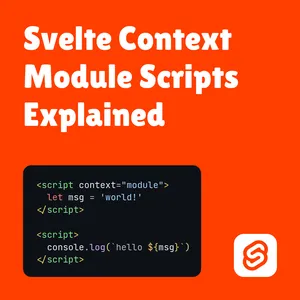By
Raqueebuddin Aziz
August 4, 2023
Freelance Web Designer & Developer

By
August 4, 2023
Freelance Web Designer & Developer
This guide assumes you are familiar with how JS scopes and modules work and have completed the svelte tutorial.
This is a simple hello world svelte component that you and I will be walking through to see how script context=module works.
<!-- HelloWorld.svelte -->
<!-- OUTER SCOPE STARTS -->
<script context="module">
import { writable } from 'svelte/store'
let message = 'world!'
const count = writable(0)
setInterval(() => {
count.update(c => c + 1)
}, 1000)
</script>
<!-- INNER SCOPE STARTS -->
<script>
$: console.log($count)
</script>
<p>hello {message}</p>
<button on:click={() => $count = 0}>Reset Count</button>
<!-- INNER SCOPE ENDS -->
<!-- OUTER SCOPE ENDS -->
Let’s see what a svelte component roughly would look like if it was written in JS to understand how context=module script works.
// HelloWorld.js
// OUTER SCOPE STARTS
import { writable } from 'svelte/store'
let message = 'world!'
const count = writable(0)
setInterval(() => {
count.update((c) => c + 1)
}, 1000)
// @SVELTE-COMPILE
export const HelloWorld = () => {
// INNER SCOPE STARTS
$: console.log($count)
return html`
<p>hello ${message}</p>
<button on:click="${() => ($count = 0)}">Reset Count</button>
`
// INNER SCOPE ENDS
}
export default HelloWorld
// OUTER SCOPE ENDS
context=module scripts only runs once, no matter how many times you use a component.context=module script tag. You can do it the other way round though.$ to their name or creating reactive variables using let in context=module script tags.Because the global scope (context=module in svelte files) is only run on the first import of a module, but the component function (the normal script tag and the html) is executed every time a component is used.
Look at the svelte example code above and then compare the scopes to the js example code above.
See how all the non context=module script variables are inside the inner scope aka inside the function thus variables defined inside a function cannot be used outside it.
The outside of the function in the .js file corresponding to the context=module script in the .svelte file.
You would have noticed that you cannot use any svelte specific syntax in context=module scripts like $: console.log($count), setInterval(() => $count++, 1000).
Instead we have to write pure JS inside context=module scripts.
The reason for this is everything inside the normal script tag inside a svelte component runs through the svelte compiler to transform the svelte specific syntax into pure JS syntax.
Look at the @SVELTE-COMPILE line in js example code above. This compilation doesn’t happen for the context=module script.
The next question you might have is why not run the outer scope (context=module script) through a compiler too and let you use the svelte specific syntax in context=module scripts? Some of the reasons are
context=module not supporting svelte syntax is great.
For e.g. if you want to define a variable that’s not reactive you can do that in context=module scripts using the let x = 1 syntax.The context=module script tag is an escape hatch so you can break out into the global scope of the current module as with normal script tags you are contained within a function scope and cannot do things you can do in a global scope like exporting variables and functions, running code once per component and sharing state across multiple usage of the same component.
Leave a comment down below if you have any questions!

 HTML Button Tag Explained
HTML Button Tag Explained © 2025 Raqueebuddin Aziz. All rights reserved.